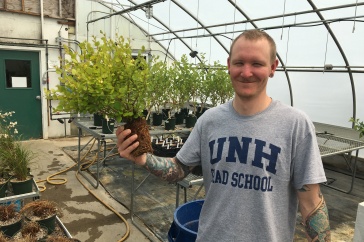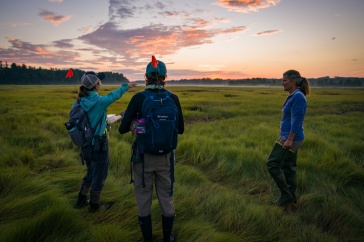
High-frequency water quality sensor technology installed at Dowst-Cate Town Forest in Deerfield, N.H. Photo Credit: Lisle Snyder
Climate change is expected to cause more droughts and stronger storms, and a new UNH study suggests that as these precipitation extremes grow more common the effect on water quality may be hard to predict. Rainfall and drought have direct impacts on the amount of carbon and nutrients, such as nitrogen, washing into our waterways, and healthy nutrient concentrations are important for maintaining fisheries, food webs and recreational value.
The research, published in the journal Geophysical Research Letters, was led by postdoctoral scientist Hannah Fazekas and co-authored by Bill McDowell, professor of natural resoures and the environment, and Adam Wymore, research assistant professor of natural resources and the environment. The researchers studied watersheds in New Hampshire and Puerto Rico to understand how extreme variability in rainfall patterns can change the concentration of nutrients that pass through waterways and the degree to which those nutrients can be broken down or eliminated along the way. They found that the type of extreme weather event matters — storms and droughts can have differing effects on nutrient loads.
“We found that during wetter-than-typical conditions, watersheds act as a conveyor belt of material to the stream network,” says Fazekas. “During warmer and drier conditions, we observed high variability in nutrient concentrations, suggesting that watersheds sometimes take up and use these nutrients before they can be transported downstream.”
Here in New Hampshire, we are already getting a taste of some of the extreme weather conditions to come.
“New Hampshire is predicted to experience more frequent and more intense extreme events, including drought,” she says. “For example, the state experienced a record-setting drought in 2020, followed by record-setting precipitation in 2021.
According to Wymore these extremes may set up ecosystem-altering nutrient bursts as once-perennial streams become more intermittent.
“During droughts and periods of low flow, excess nutrients can build up on the landscape,” he says. “When the climate then swings back to the other extreme — a period of heavy precipitation — those excess nutrients are washed into watersheds over a very short period of time. This concentrated flow of nutrients could cause increased algal blooms in estuaries like the Great Bay leading to degraded water and habit quality.”
Ultimately, he says, we still know very little about what is happening in our watersheds during droughts and periods of low flow. By improving our ability to predict nutrient concentrations in waterways, we will be able to better manage the ecological and economic damage caused by climate extremes.
-
Written By:
Benjamin Borgmann-Winter | UNH College of Life Sciences and Agriculture



















































